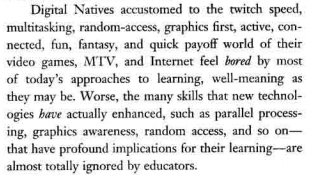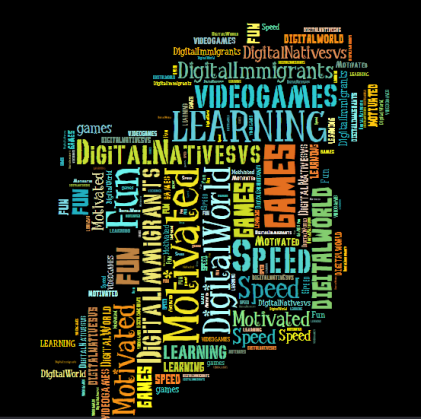I grew up in the 80s…there I said it. I had big hair, stretch jeans, LA Gears and a love for Def Leopard! I didn’t have a cell phone, facebook or instagram account (thank goodness!) but I did have floppy discs in my binder and went to a computer lab for class. We played Asteroids on a Commodore 64 (after waiting forever for the tape to load…surely some of you know what I’m talking about!) and Donkey Kong on the neighbour’s Playstation. Ah, good times!
 Photo Credit: Rik Goldman via Compfight cc
Photo Credit: Rik Goldman via Compfight cc
(For the music aficionados this is actually Billy Sheehan from Mr. Big…and yes, I liked them too!)
Times sure have changed! Our learners have too.
When I read Marc Prensky’s Computer Games and Learning: Digital Game-Based Learning as part of the requirements for my MinecraftEdu MOOC, I was immediately taken with his idea of digital natives vs. digital immigrants. I was hopeful that I could classify myself in the former category–I don’t transfer from paper to computer; I collaborate online with colleagues; I’m active on social media–but alas, despite these savy digital behaviours, I fear I am an immigrant!
In his article, Prensky outlines ten ways digital natives are different and how we as teachers need to keep pace with their new learning style. Here’s his summary of how digital natives are different (though I encourage to check out the full article–a lengthy but fascinating read):
Ouch! That’s a damning indictment for many of today’s educators. So, can you teach an old dog new tricks or at least use their new tricks to our purposes? Prensky says we can. He purports that kids are already learning real life skills from playing video games. This is what he says they’re learning:
1. How – Game specific skills (useful or not depending on the game) and non-specific skills (ex. multi-tasking, perception)
2. What – The nature of rules and comparing rules in real life
3. Why – Game strategy and the nature of consequences
4. Where – Cultural context and ideology like good vs. evil and other messages within the game that become part of their schema or filter
5. When & Whether – Making moral judgments; comparing what the game is teaching them to their experiences in real life
There’s no question that there are both positive and negative aspects to the skills they are learning from gaming. (I’m pretty sure the old folks said the same thing about what my generation was learning from TV, right?!) It’s all about perspective, isn’t it?
 Photo Credit: JD Hancock via Compfight cc
Photo Credit: JD Hancock via Compfight cc
“One wonders whether there’s any limit to what can be done in merging the addictive elements of computer games with effective instruction.” Bob Filipczak
Prensky goes on to detail how to create games that are both fun and educational, a fine line to walk especially when educational designers typically “suck the fun out of” the game! (p. 13) His words, not mine! Despite the digital native’s desire for eye candy (ie. great visual imagery) it is the gameplay that makes or breaks a game. This is tough for instructional designers who are bound by curriculum. The other tough paradigm to shift is that for an educational game to fly it’s got to put fun first and learning second. (Read that again teachers! Not an easy task in this age of standardized testing and outcome accountability. Nevertheless, it is the task set before us.)
I sat in my staff room the other day and heard one of my colleagues mention how she had told her students she wasn’t here to put on a show for them. Hmmmm…perhaps we need to start?? It’s clear that many of us need some help and some resources at hand to begin. Here’s one place to start. Reaching digital natives (aka my young students!) is the very reason I’m researching game-based learning and taking the MinecraftEdu MOOC to begin with.
Prensky’s predicts that like the rise of the auto industry in the industrial world, digital game-based learning will become the norm in our digital world. With this new learning paradigm, educational DGBL has a lot of promise:
- Increased learner motivation
- Improved learning, competence and behaviour (and thus economy)
- Increased rate of learning
- Talent will out / easy access to successful, effective instruction
- Game industry will focus on authors and style rather than publishers
- Will gain worldwide exposure (like the movie industry)
- Internet will be a competitive forum for best learning games
- Gamers will enjoy classic educational games and look forward to new releases
With so much promise of digital game-based learning being the future, what’s a digital immigrant to do?
What every other immigrant does…
Learn the language, venture out, ask for help, and immerse yourself in their digital world…And yes, play a few video games too!
Learn more about Marc Prensky’s vision for educators to become ‘future-cators’ rather than ‘pastecators’.
Or check out his website.
If you have a moment to weigh in please add to my google doc Pros & Cons of Video Games in the Classroom.
Thanks for reading!


[…] of gaming in the classroom. My previous posts, ‘Turns out Gaming is Good for You’ and ‘Digital Native or Immigrant?’, explore some of the viewpoints and research presented in those resources. Jane McGonigal’s […]